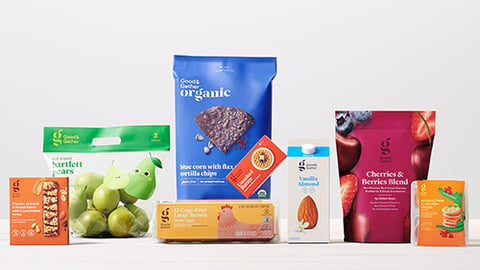PLMA: Supermarket Private Label Sales Up 13.2%
As the pandemic brought unparalleled volatility to U.S. grocery retail in 2020, consumers continued to favor store brands for about one of every four purchases across all major food and nonfood categories, according to the Private Label Manufacturers Association (PLMA).
PLMA’s 2021 Private Label Yearbook shows that retailers’ private brands accounted for 23.4% of all units sold for the 52 weeks ended Dec. 26, 2020, in NielsenIQ’s calculation of all outlets combined, which includes total U.S. supermarkets, mass, club and dollar channels, as well as drug chains.
About one out of every five dollars expended by shoppers in all outlets, or 19.5%, was for the retailer’s store brand. Both figures were unchanged from the market shares reported for the full year prior to the pandemic. The year 2020 saw COVID-related retail impacts that ranged from panic buying early on to the near doubling of online purchases over 2019 sales.
Yet store brands sales saw an increase of 12% for the year, keeping pace with national brands and maintaining market share, despite a number of supply chain interruptions affecting high demand categories, and a major shift of purchasing from foodservice to grocery channels as consumers everywhere were forced to adjust their lifestyles around remote work.
Combining socially distanced shopping in stores with online purchases for curbside pickup and home delivery, consumers spent $16.5 billion more (+11.6%) on store brands and $86 billion more (+11.8%) on all brands in the country’s retail stores compared to the year prior.
Contributing to the increase was the impact of traditional restaurant and other foodservice dollars that flowed into the grocery space, whether from outright closures of bars and restaurants, restrictions on dining out, cancelled vacations and travel, or the need to substitute in-home for daily commuter and office meals, as well as school lunches.
The National Restaurant Association says restaurant and foodservice industry sales fell by $240 billion in 2020 from an expected level of $899 billion and that 110,000 eating and drinking establishments closed for business — temporarily or permanently. Diverted foodservice dollars were welcomed by the grocery industry, but they also posed a massive challenge for its distribution systems, as did considerable stocking up by panicked shoppers, particularly in the first quarter of 2020. Such overbuying also contributed to the swelling of last year’s grocery sales total.
“Analysis needs to take these anomalies of the 2020 data into account,” said PLMA President Peggy Davies. "But comparisons to pre-pandemic trends and projections notwithstanding, store brands maintained their well-established position in the marketplace, as retailers and private label manufactures succeeded in supplying the country with critical food and essential non-food products in the face of extreme volatility. The 2020 sales figures bear that out.”
NielsenIQ data show retailers’ store brands surged across all outlets for a record $158.8 billion in private label sales, even as sales for all brands reached a record $816 billion. Private label units also saw an increase of 7.2%, matching the growth of all brands. Private label’s market share for all outlets remained steady at 19.5% of sales volume and 23.4% of all units sold.
In the mass channel, consisting of mass merchandisers, club and dollar stores, PLMA calculates store brands sales increased by $8.1 billion (11.7%) to a total of $77.8 billion, and store brands unit volume was up 8.2%. Both measures outpaced the mass channel overall, where manufacturers brands saw gains of 8.5% in dollars and 4.9% in units. As a result, store brands market share unfazed by pandemic’s impact increased to 21.5% (+0.5 percentage points) of total dollar sales and 25.5% (+0.6 percentage points) of all units sold.
In U.S. supermarkets, which for a number of years had only moderate, mostly inflationary sales growth and declining unit volumes, 2020 brought a reversal of trends and store brands factored significantly in the turnaround. Private label sales increased by $8.5 billion to a record $27.3 billion (13.2%), while units were up 7.1%. Manufacturers' brands fared somewhat better however, as the channel overall captured a 16% sales increase to a record $403.6 billion overall in tandem with a unit volume gain of 9.4%. Private label had lower annual shares in the channel as a whole, at 18.1% of dollars (-0.4 percentage points) and 22.3% of units (-0.5 percentage points). The drug channel fared less well than others, reporting $130 million lower store brands sales (- 1.7%) against a loss of more than -6% unit volume for all brands sold in the channel versus a year ago. National brands sales increased +0.8% — an indication that price inflation may have been a factor as private label market share for units remained unchanged at 15.7%, while dollar share declined -0.3 percentage points to 15.9%.
NielsenIQ’s Kara Sheesley, VP, retail engagement and U.S. industry relations, cited household panel data for 2020 as proof that purchasing private label is ingrained in U.S. consumers’ behavior: “Fully 99% of households told us they bought private label last year.”
Of note, the panel research data placed store brands market share for 2020 at 23% of all grocery dollars and 25% of units by taking account of sales at retailers not counted within the point-of-sale scan data universe. The figure includes additional private label sales of approximately $40 billion annually from consumer purchases at leading club, discount retailers and others with extensive private brand programs.




